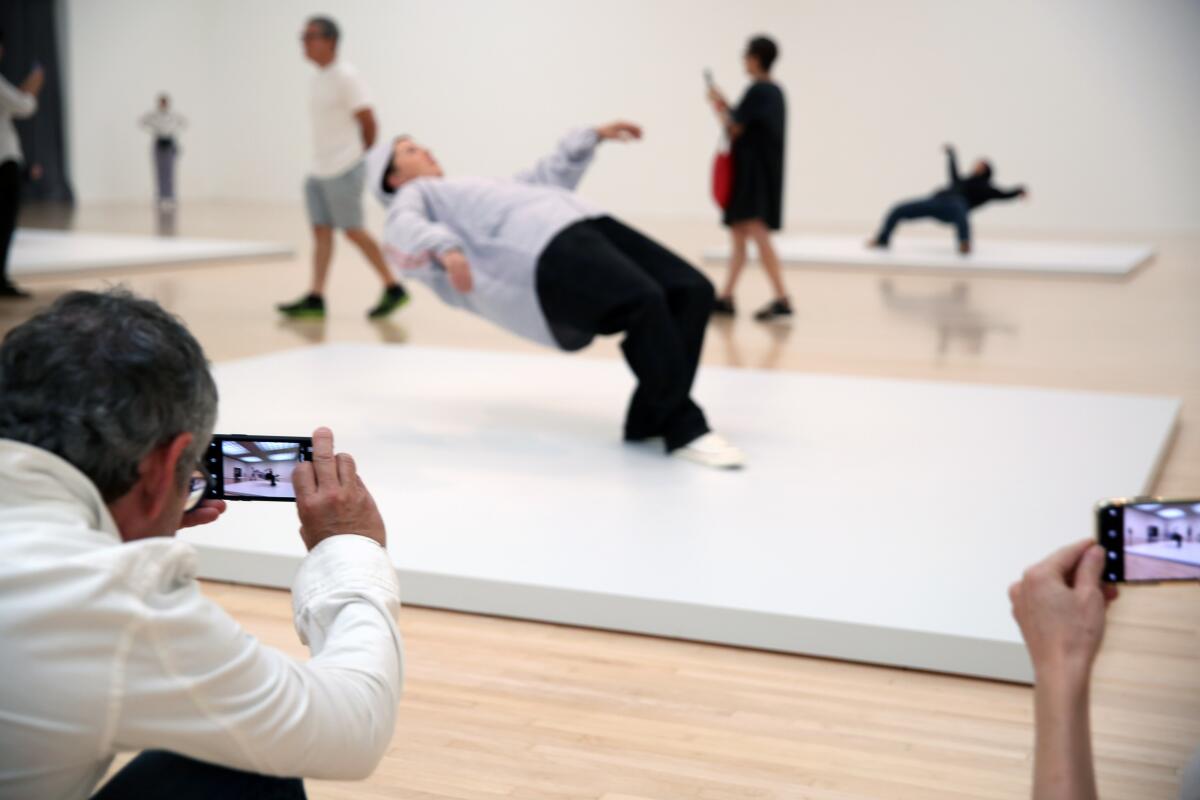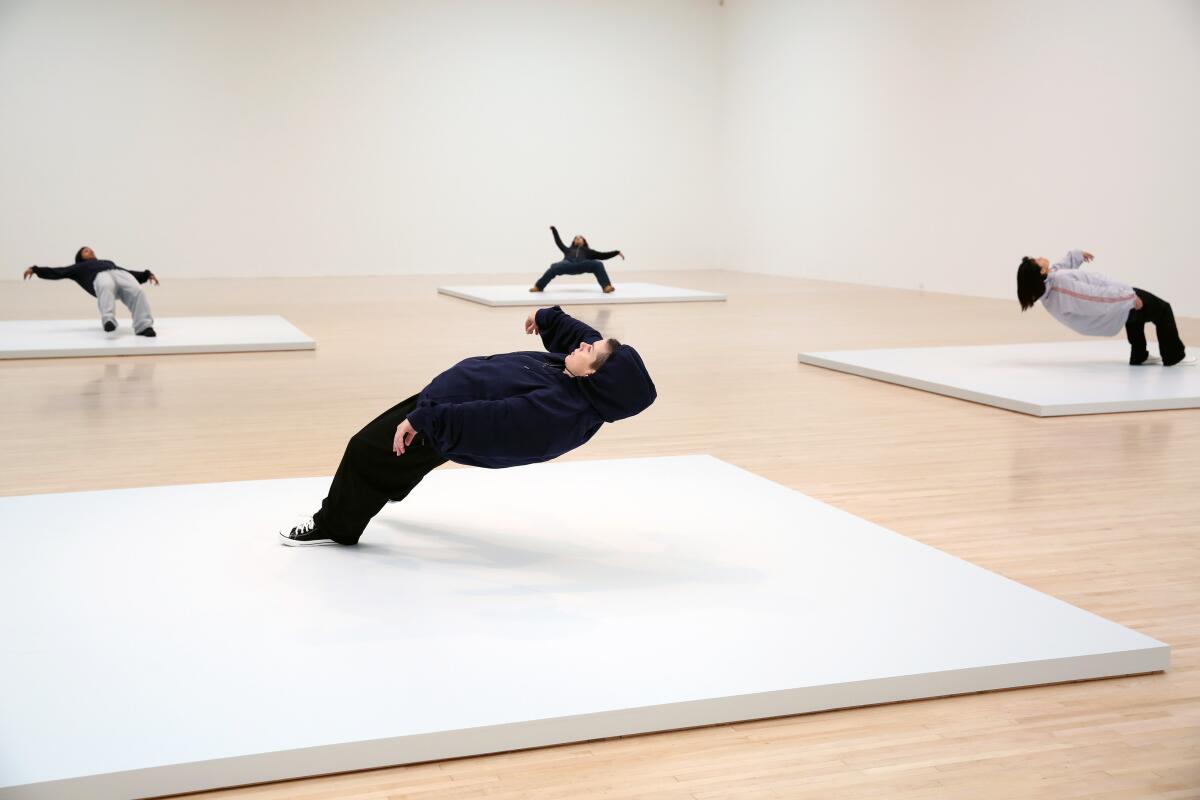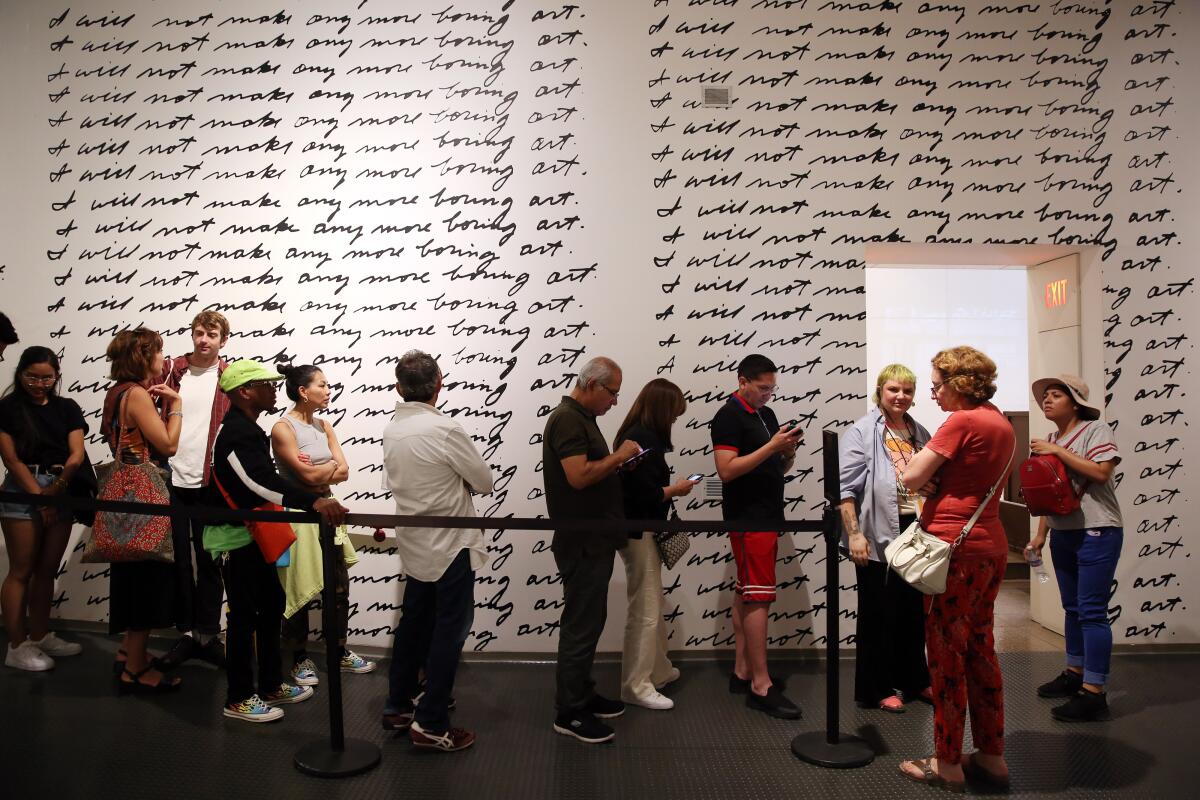Can performance art be owned? Why the genre is often missing in museum collections

- Share via
On a Saturday afternoon, visitors to the Museum of Contemporary Art in L.A. are waiting up to 45 minutes to see Chinese artist Xu Zhen’s living sculptures in the museum’s north gallery. Under the milky lights and awash in the room’s palette of stark white, black and gray tones, curious onlookers ogle the four human figures, all in baggy streetwear, who remain stock-still in impossible, gravity-defying positions.
The work is performance art, titled “In Just a Blink of an Eye.” As it forces viewers to question the laws of physics, it also addresses states of limbo, the fluidity of time and the fragility of the human condition. It will be on view Saturdays and Sundays through Sept. 1, at which point …
For the record:
12:46 p.m. Aug. 8, 2019An earlier version of this article misstated where “In Just the Blink of an Eye” has been installed at MOCA. It’s in the north gallery, not the south gallery.
Well, that’s where the questions begin.
When “In Just a Blink of an Eye” closes, MOCA — which recently acquired the work for its permanent collection — can’t place this art in storage, as it would a sculpture or painting.
So what does happen to a performance when it goes off-view?
The mystery behind how Xu’s performers hold their elaborate poses might be the most common question swirling at MOCA, but the museum’s acquisition of the ephemeral work broaches a slew of other questions: How does a museum collect performance? And what does it mean to own one?
The Times talked with the Getty, the Broad, the Guggenheim, the Tate and other art institutions for answers that are at times as unexpected as those “Blink of an Eye” poses.

What does it mean for a museum to collect performance art?
It’s a work of art in the collection, like any painting, sculpture or installation. This art is just performed: It’s durational and involves real people. The artist typically provides instructions for how to stage and document the work. When it’s re-staged, the concept and overall choreography remain intact, but it’s never exactly the same. Each time the work is re-enacted, a new date is added to its title — “In Just a Blink of an Eye” (2005/2019), for example.
“You’re collecting an idea and the documentation, if the artist has stipulated, but sometimes they prefer it to be fleeting and ephemeral and totally experiential,” says Amanda Hunt, director of education and senior curator of programs at MOCA.
How common is it for museums to collect performance art?
The Tate in Britain, along with the Museum of Modern Art and the Guggenheim in New York, are leading collectors of performance work, but the acquisition of it is not common at most museums and has become more popular within only the last 15 years or so. Before the Xu acquisition, MOCA owned just one performance work, “Temperament and the Wolf” (2014/2019), created by Puerto Rico-based duo Allora & Calzadilla and acquired in 2015. At its annual benefit this year, MOCA re-staged the work, a double receiving line in which museum staffers and board members welcomed visitors into the dinner area after cocktails.
The Hammer Museum owns only one performance artwork, Mario García Torres’ “I Am Not a Flopper” (2007/2014) — a one-act monologue, written as an imagined tell-all by fictitious director Alan Smithee. But the museum regularly shows performance art and collects documentation from important historical works. The Getty Research Institute has deep holdings of archival material from performance artworks but doesn’t actually own any performances. Nor does the Los Angeles County Museum of Art or the Broad, though the latter has commissioned performances as recently as last month, when Mecca Vazie Andrews staged an “artist intervention” at the museum related to the exhibition “Soul of a Nation: Art in the Age of Black Power, 1963-1983.”
Does the museum own sole rights or can another entity stage the work?
Generally, collectible performance work is considered editioned work, so multiple institutions can own the same work and the rights to perform it as often as they wish. If it’s an open edition, the work can continue to be acquired by additional collectors. If the work comes in a limited edition of four, for instance, then four owners would retain the right to stage it or lend it. If the artist retains an edition, he or she can lend or stage it as well. Contractual agreements vary greatly, but typically, a performance work is purchased for a fee and doesn’t involve additional artist fees when it’s performed again.
What happens to a performance piece when it’s not being staged?
The physical elements in the work, such as the performers’ clothing or any specially built props, are stored according to museum procedures. The artist’s instructions, along with any documentation of the work, such as photographs or video, are also stored.

What are some of the responsibilities in collecting performance?
First and foremost, a museum is entrusted with keeping the piece alive by showing it, even — especially — after the artist has died. “A live work needs to continue to live,” says REDCAT interim director Edgar Miramontes. “You can archive it through documentation, but it lives only in performance.”
The institution is also responsible for preserving, conserving and maintaining the work, along with documenting it — procuring detailed execution instructions from the artist. “You meet the artist or people who have performed it and get an oral history,” MOCA Director Klaus Biesenbach says. “You capture as much history — in scores, in photographs, in documentation — as possible to be true to the piece.”
Training staffers and audiences to engage with the work can be a challenge, Hunt says. Visitors may want to touch the work, for instance. Biesenbach adds that it’s also a challenge to produce the work properly, to honor the artist’s vision. Others say conservation is the big issue — that because the practice of collecting live performance is relatively new, the standards for conserving it are still evolving and unclear. “How do you care for a performance work if your institution has never done it before?” Hunt asks.
Then there’s the fact that some museum stakeholders may balk at paying money for something intangible, says Guggenheim curator Nat Trotman. “Donors, patrons, trustees, people who are outside of the curators but who are vetting and approving acquisitions still aren’t entirely comfortable with the idea of collecting something that ostensibly is not a thing.”
Can a performance be lent?
Yes. In 2010, MoMA lent Tino Sehgal’s “Kiss” (2002) to the Guggenheim, for example, for the exhibition “Tino Sehgal.”
MOCA says “In Just a Blink of an Eye” marks a new dedication to collecting performance art. Why is this important to the museum?
Biesenbach cites MOCA’s rich history of commissioning and exhibiting performance art. When its Geffen Contemporary satellite debuted in 1983 (then called the Temporary Contemporary), it featured “Available Light,” a performance collaboration between Lucinda Childs, Frank Gehry and John Adams. But performance art wasn’t as well represented in the museum’s collection, says Biesenbach, who co-founded MoMA’s Department of Media and Performance Art. “We’re catching up with our own history,” he says, “because we were pioneers in showing it.”
What’s on MOCA’s wish list to collect?
Biesenbach wouldn’t reveal what he has his eye on, but Hunt noted historical work by Simone Forti and contemporary work by Simone Leigh, as well as commissioning new work that would debut at the museum.
Why the Xu Zhen piece?
“It visualizes that performance art is both sculpture and life,” Biesenbach says. “It’s a living sculpture in its multiplicity, in variations. We are definitely declaring this as a beginning.”
Patrick Kennelly, artistic director of Santa Monica’s Highways Performance Space, says he’s encouraged by the trend of museums acquiring performance art.
“Performance art is pretty low on the totem pole in terms of the work that’s been exhibited and promoted by major institutions. It’s always been more of an underground thing,” he says. “So it’s nothing but good for performance artists and the historical documentation of works, especially because it’s so ephemeral — all you have is the documentation, the stories of these things.”
----------
Case studies: 3 significant performance artworks — and who owns them
Museums’ acquisitions of performance art have gained momentum in the last 15 years.
One reason why?
“Artists started selling their performance works as collectible objects,” says the Guggenheim’s Trotman. “They began looking beyond the repertory model of support for performance art, the tradition of creating a work and performing it and touring it for fees. So it came from a change in how artists were thinking about their work — and museums reacted to it.”
The Tate began collecting performance art with Roman Ondák’s “Good Feelings in Good Times” (2003). The museum purchased it in 2005. It’s inspired by the artist’s memory of waiting in long lines for food in communist-era Slovakia and takes the form of a queue that runs, intermittently, throughout the museum’s galleries.
MoMA in New York acquired Tino Sehgal’s “Kiss” (2002), which the artist calls a “constructed situation,” in 2008. To ensure his work exists only in the moment or through verbal recollections, the artist has stipulated that “Kiss” — which involves two dancers in a continuous, evolving embrace and kiss — may never be documented in any form, including photos. In 2010, the museum lent the work to the Guggenheim for the exhibition “Tino Sehgal.”
The Guggenheim in New York owns artist duo Gerard & Kelly’s “Timelining” (2014), which it acquired in 2014. Paired performers move in a circular pattern as they recite bits of their personal history in reverse-chronological order. The piece, the Guggenheim says, “explores the intertwined lives of the performers through nuances of intimacy, intersubjectivity and memory.”
More to Read
The biggest entertainment stories
Get our big stories about Hollywood, film, television, music, arts, culture and more right in your inbox as soon as they publish.
You may occasionally receive promotional content from the Los Angeles Times.











